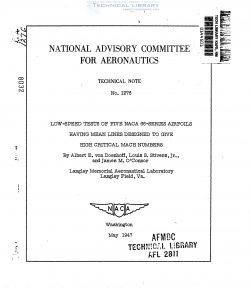naca-tn-1276
- Version
- 145 Downloads
- 3.39 MB File Size
- 1 File Count
- December 4, 2016 Create Date
- December 4, 2016 Last Updated
National Advisory Committee for Aeronautics, Technical Notes - Low Speed Tests of Five NACA 66 Series Airfoils Having Mean Lines Designed to Give High Critical Mach Numbers

The possibility of developing an_airfoil to carry
lift without decreasing the critical Mach number below
that of the basic thickness form at zero lift has been
investigated. Low-speed tests of five NACA 66-series
airfoil sections having a thickness-chord ratio of 0.16
were made in the Langley two-dimensional low—turbulence
pressure tunnel. By designing the mean line to carry
load over the portions of the airfoil section having low
induced velocities an effective design lift coefficient
(the lift coefficient corresponding-to the center of
the range of high critical Mach numbers as obtained
from the experimental pressure distribution) of approxi—
mately 0.1 was obtained for several airfoil sections
without causing the maximum predicted critical Mach
numbers to be appreciably less than the critical Mach
number for the basic thickness form at zero lift. The
maximum lift coefficients and the drag coefficients in
the low—drag range were ap roximately the same for these
airfoils as for the NAGA 62-series airfoil sections
having the same thickness and approximately the same
effective design lift coefficient with the uniform—load
mean line. The low-drag range at a Reynolds‘number
of 9 x 106 decreased with increase inadesign-lift coef-
ficient above a value of 0.2. The pitching-moment
coefficients were larger than those of airfoils having
the same effective design lift coefficients with the
uniform~load mean line but were not nearly so large as
those corresponding to the design load distribution.
Recommendations concerning the use of the airfoils
at high speeds cannot be made because of the lack of
test data at high Mach numbers.
A large amount of work has been done on the problem
of designing airfoil that have high critical Mach
numbers. The NAGA lz—series airfoils, presented in
reference 1, have a thickness distribution that gives
unusually high critical Mach numbers for a given
thickness—chord ratio. This series of airfoil sections,
however, has high critical Mach numbers over only a
limited range of_lift coefficients. Many of the
NACA 6-series airfoils, data for which are presented
in reference 2, have critical Mach numbers somewhat
lower than those for the corresponding airfoils of the
NACA l6-series but have high critical Mach numbers over
a considerably larger range of lift coefficients.
| File | Action |
|---|---|
| naca-tn-1276 Low Speed Tests of Five NACA 66 Series Airfoils Having Mean Lines Designed to Give High Critical Mach Numbers.pdf | Download |

Comment On This Post